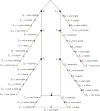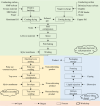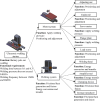A risk analysis method for potential failure modes in the lithium-ion battery assembly process based on optimized FMEA and DHHFLTS
- PMID: 40754612
- PMCID: PMC12319098
- DOI: 10.1038/s41598-025-12681-5
A risk analysis method for potential failure modes in the lithium-ion battery assembly process based on optimized FMEA and DHHFLTS
Abstract
To enhance product quality and operational safety of lithium-ion batteries, this paper proposes a risk analysis method based on an optimized Failure Modes and Effects Analysis (FMEA). Firstly, as an evaluation language with a double-hierarchy structure, the Double Hierarchy Hesitant Fuzzy Linguistic Term Set (DHHFLTS) can both express rich semantics and accurately capture the evaluators' hesitancy. Secondly, the Similarity Measure (SM) and Water Filling Theory (WFT) are utilized to calculate the consensus degree of evaluator's evaluation information, thereby determining the weight information. Compared to the current methods that calculates weights based on the dispersion of evaluation information, SM-WFT is more suitable for FMEA. Then, the Combined Compromise Solution (CoCoSo) employs multiple aggregation methods for compromise calculation, thereby minimizing the likelihood of identical risk rankings in FMEA. Finally, addressing the difficulty of experimentally verifying the calculation results of new methods, this paper proposes a Multi-Objective Aggregation Technique (MOAT). By constructing a multi-objective mathematical model, a comparative analysis is conducted on the risk ranking results and evaluation information obtained from the new method versus other methods. At the end of the paper, a case study on risk analysis of potential failure modes in the lithium-ion battery assembly process is presented to verify the practicality and objectivity of the new method.
Keywords: CoCoSo; Double hierarchy hesitant fuzzy linguistic term set; Multi-Objective aggregation technique; Potential failure modes risk analysis; SM-WFT.
© 2025. The Author(s).
Conflict of interest statement
Declarations. Competing interests: The authors declare no competing interests.
Figures














Similar articles
-
Prescription of Controlled Substances: Benefits and Risks.2025 Jul 6. In: StatPearls [Internet]. Treasure Island (FL): StatPearls Publishing; 2025 Jan–. 2025 Jul 6. In: StatPearls [Internet]. Treasure Island (FL): StatPearls Publishing; 2025 Jan–. PMID: 30726003 Free Books & Documents.
-
Failure mode identification and effects analysis of mobile X-ray machine using selected MADM techniques.Sci Rep. 2025 Jul 8;15(1):24534. doi: 10.1038/s41598-025-09518-6. Sci Rep. 2025. PMID: 40628916 Free PMC article.
-
Scrutinizing the applicability of blockchain in the sustainability of supply chains using an intelligent fuzzy multi criteria decision making.Sci Rep. 2025 Jul 28;15(1):27442. doi: 10.1038/s41598-025-06776-2. Sci Rep. 2025. PMID: 40721718 Free PMC article.
-
Systemic pharmacological treatments for chronic plaque psoriasis: a network meta-analysis.Cochrane Database Syst Rev. 2021 Apr 19;4(4):CD011535. doi: 10.1002/14651858.CD011535.pub4. Cochrane Database Syst Rev. 2021. Update in: Cochrane Database Syst Rev. 2022 May 23;5:CD011535. doi: 10.1002/14651858.CD011535.pub5. PMID: 33871055 Free PMC article. Updated.
-
Systemic pharmacological treatments for chronic plaque psoriasis: a network meta-analysis.Cochrane Database Syst Rev. 2020 Jan 9;1(1):CD011535. doi: 10.1002/14651858.CD011535.pub3. Cochrane Database Syst Rev. 2020. Update in: Cochrane Database Syst Rev. 2021 Apr 19;4:CD011535. doi: 10.1002/14651858.CD011535.pub4. PMID: 31917873 Free PMC article. Updated.
References
-
- Wu, X. X. et al. Toward circular energy: exploring direct regeneration for Lithium-Ion battery sustainability. Adv. Mater.36, 2403818. 10.1002/adma.202403818 (2024). - PubMed
-
- Zhao, Y. H. et al. Manufacturing of lithium battery toward deep-sea environment. Int. J. Extreme Manuf.7, 022009. 10.1088/2631-7990/ad97f6 (2024).
-
- Muller, N., Quinsat, Y. & Tournier, C. L-PBF AM process failures causal chain: an FMEA-based monitoring approach for process control. Int. J. Prod. Res.62, 8443–8461. 10.1080/00207543.2024.2342030 (2024).
-
- Rah, J. E., Manger, R. P., Yock, A. D. & Kim, G. Y. A comparison of two prospective risk analysis methods: traditional FMEA and a modified healthcare FMEA. Med. Phys.43, 6347–6353. 10.1118/1.4966129 (2016). - PubMed
-
- Zhang, P., Zhang, Z. & Gong, D. An improved normal wiggly hesitant fuzzy FMEA model and its application to risk assessment of electric bus systems. Appl. Intell.54, 6213–6237. 10.1007/s10489-024-05458-2 (2024).
Grants and funding
LinkOut - more resources
Full Text Sources

